The woman selected her victim because she believed him to be a Muslim or a Hindu. “The defendant is accused of committing what is every subway commuter’s nightmare: Being suddenly and senselessly pushed into the path of an oncoming train,” She told the police: “I pushed a Muslim off the train tracks because I hate Hindus and Muslims ever since 2001 when they put down the twin towers I’ve been beating them up.” The woman conflated the Muslim and Hindu faiths in her comments to the police and in her target for attack, officials said.”
(
see all the article)
I can’t believe that hate and predjudice may provoke crimes like that. I believe in respect, acceptance, dialogue. That’s why, as an artist, I am working at a project like this, The Finger and the Moon, to give my little contribution at the acceptance of other beliefs and to fight againts fanaticism and violence.
class="post-472 post type-post status-publish format-standard hentry category-english category-dialog category-blognetwork category-picturesvideo category-project" id="post-472
Posted on: December 13th, 2012 by Liuba
The Finger and the Moon #3 has been prepared by almost a year of research and contacts in Genoa. Artist Liuba, supported by anthropologist Barbara Caputo, spent time in Genoa investigating the human geography, searching for various religious communities in town, visiting them and explaining the project to them, in order to recruiting people who wish to perform with Liuba.
The process of meeting and involving people in the performance is part of the piece and it’s documented by photos, videos and writings. We believe that art needs to go out of museums and galleries, and it must become an integral part of the fabric of our society.
Here are some pictures:


With Pastors at the Anglican Church
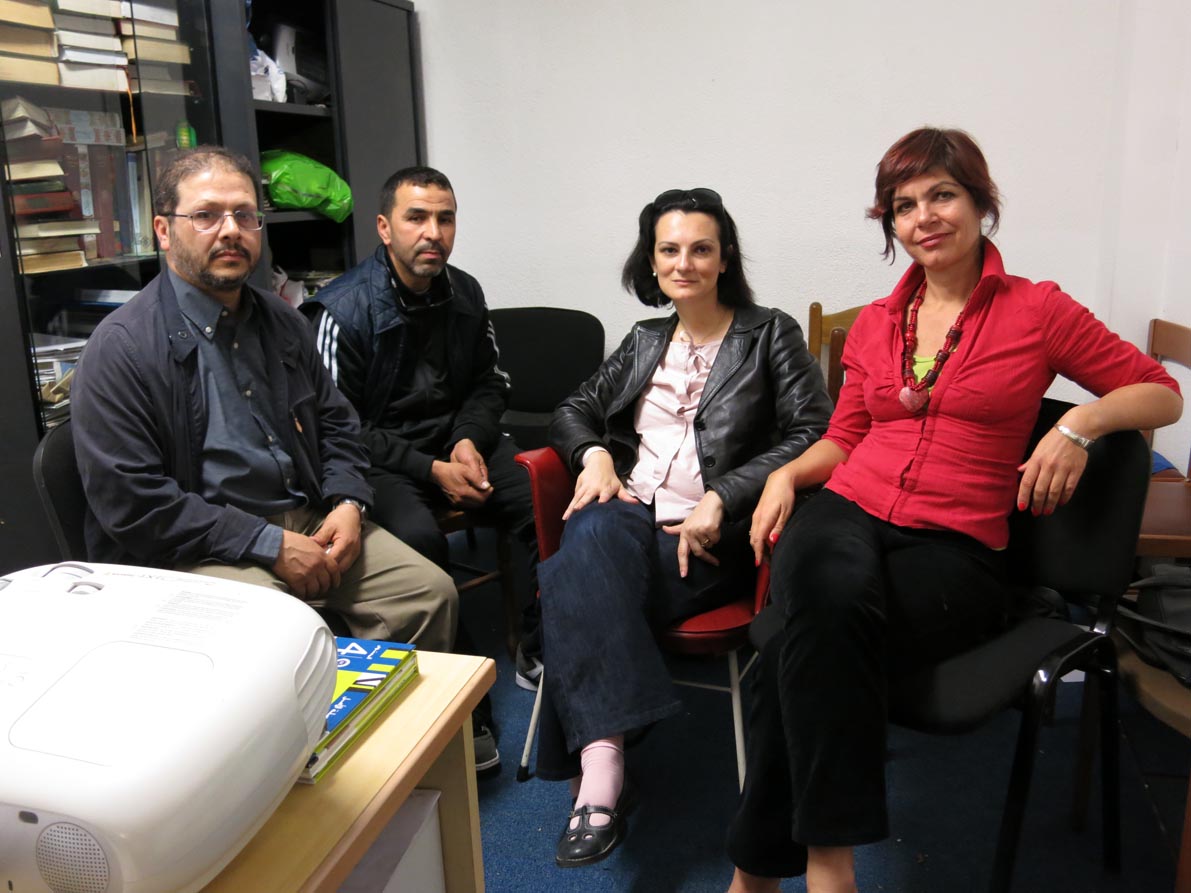
with Imam at Sampierdarena Islamic Center
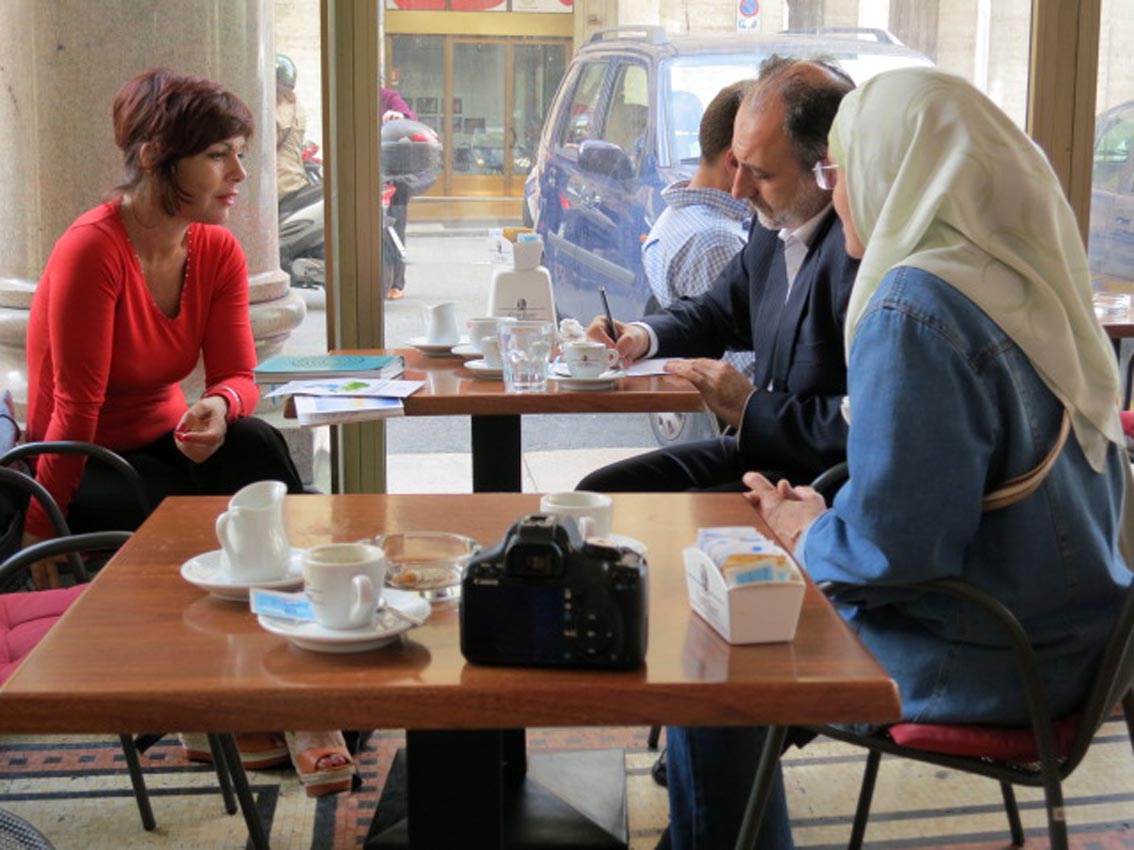
With European Muslims League President

With Mr.Lal, sikk community
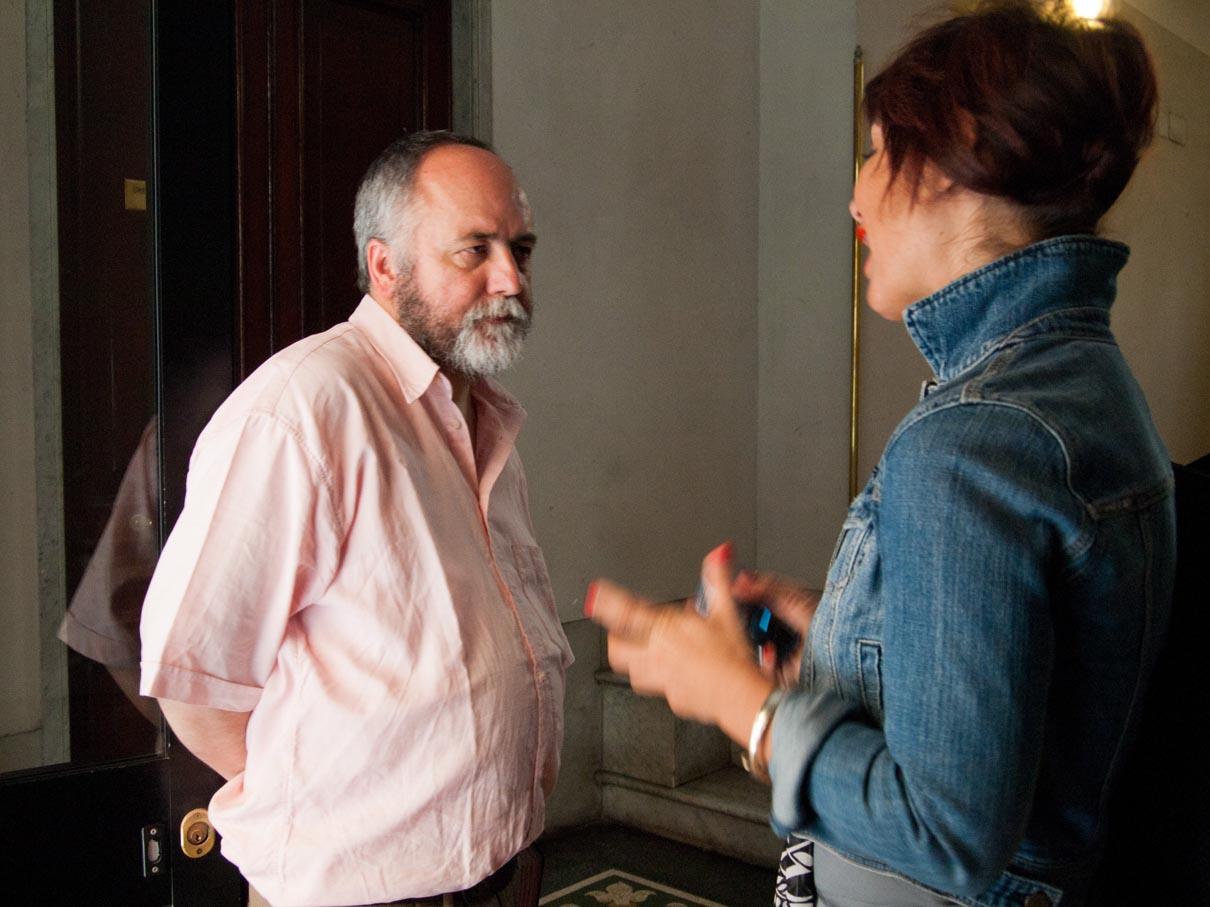
With Valdese Church Pastor
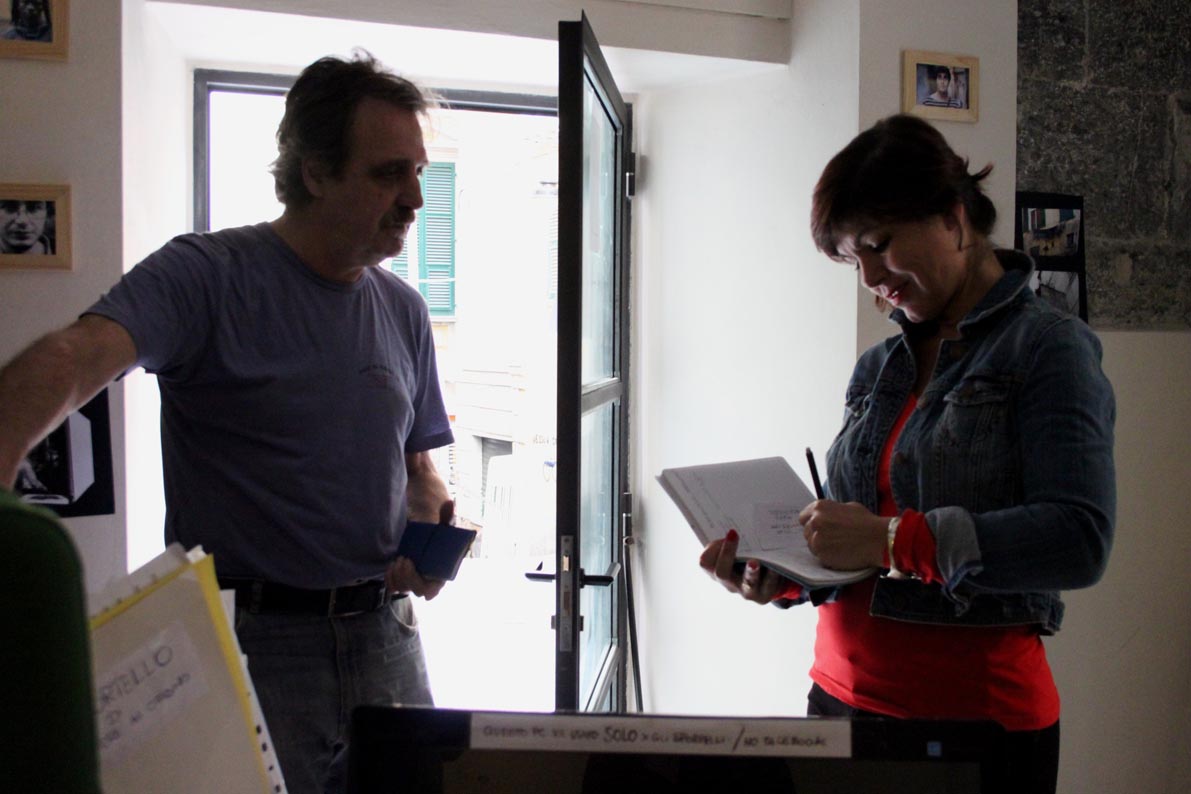
Ghett’up Civic Center
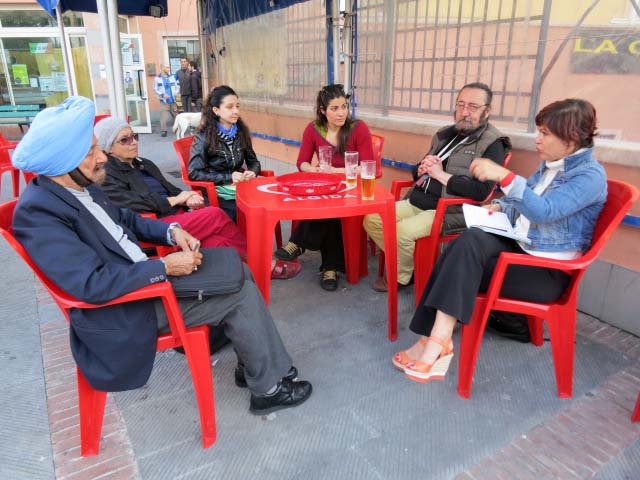
Questions, explications and programmation
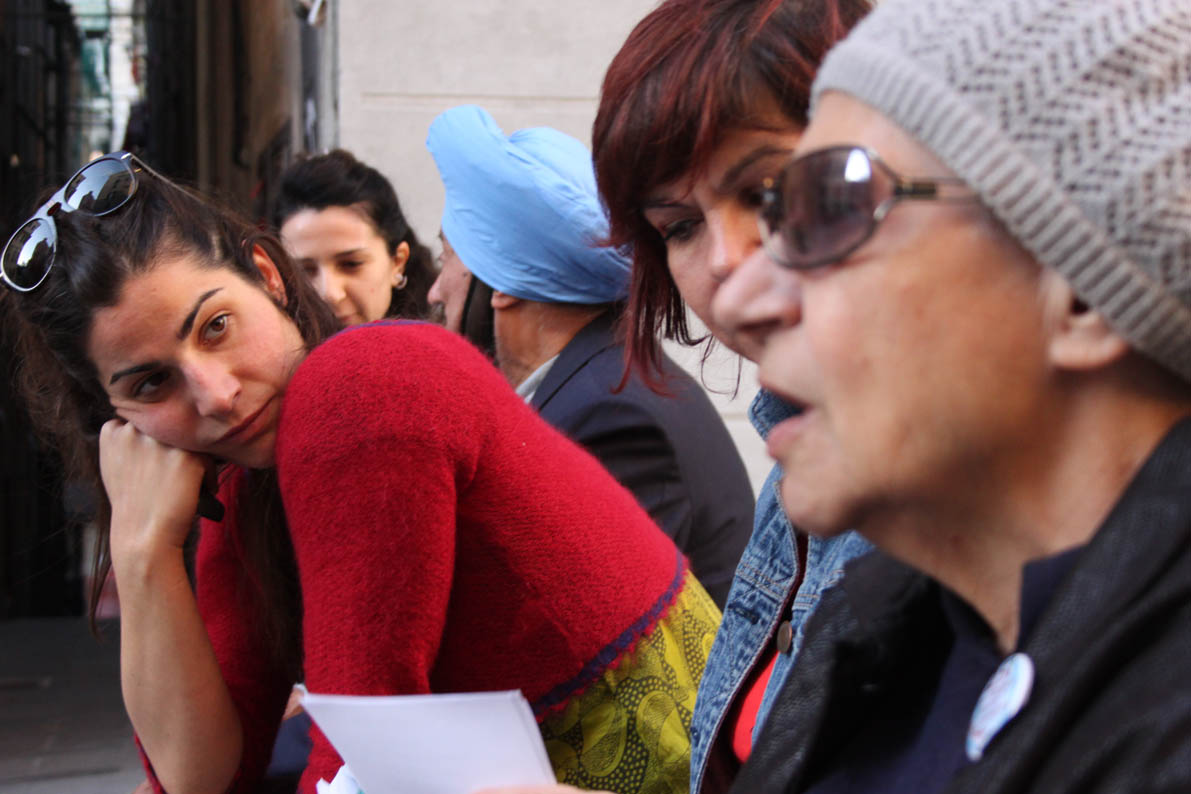
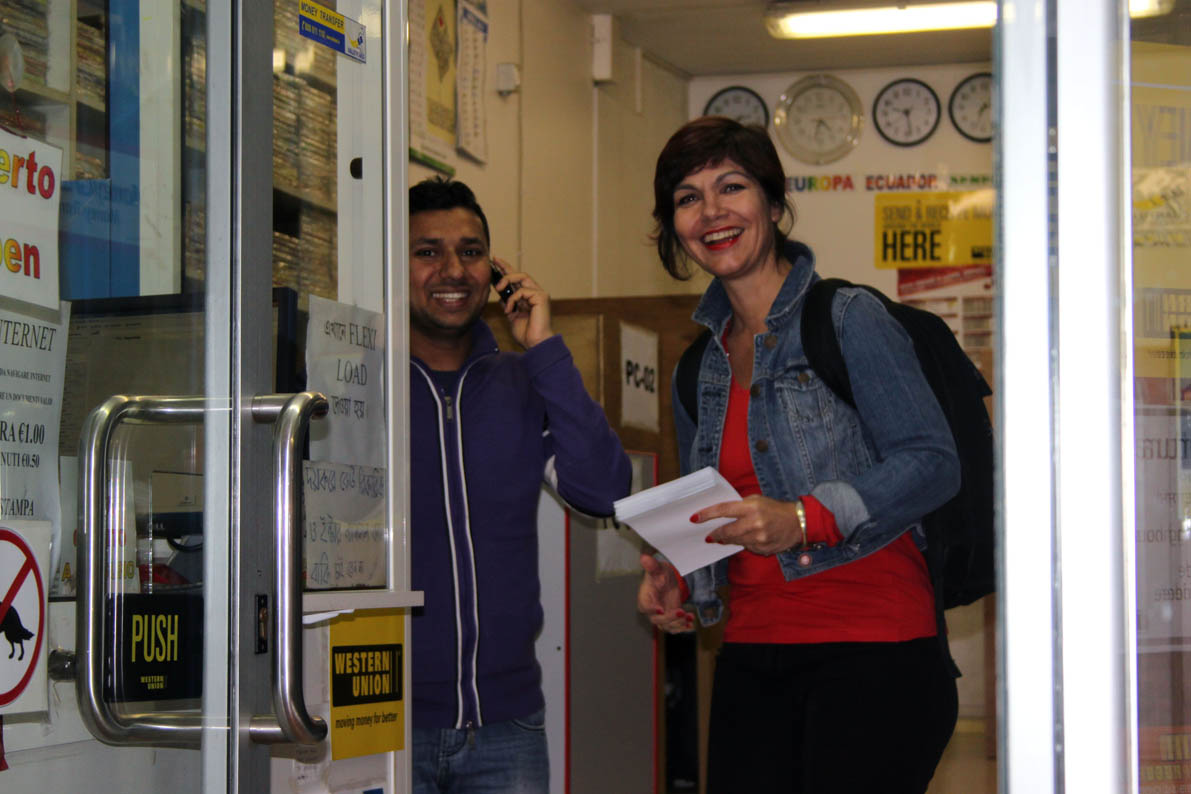
Sri Lanka community research….
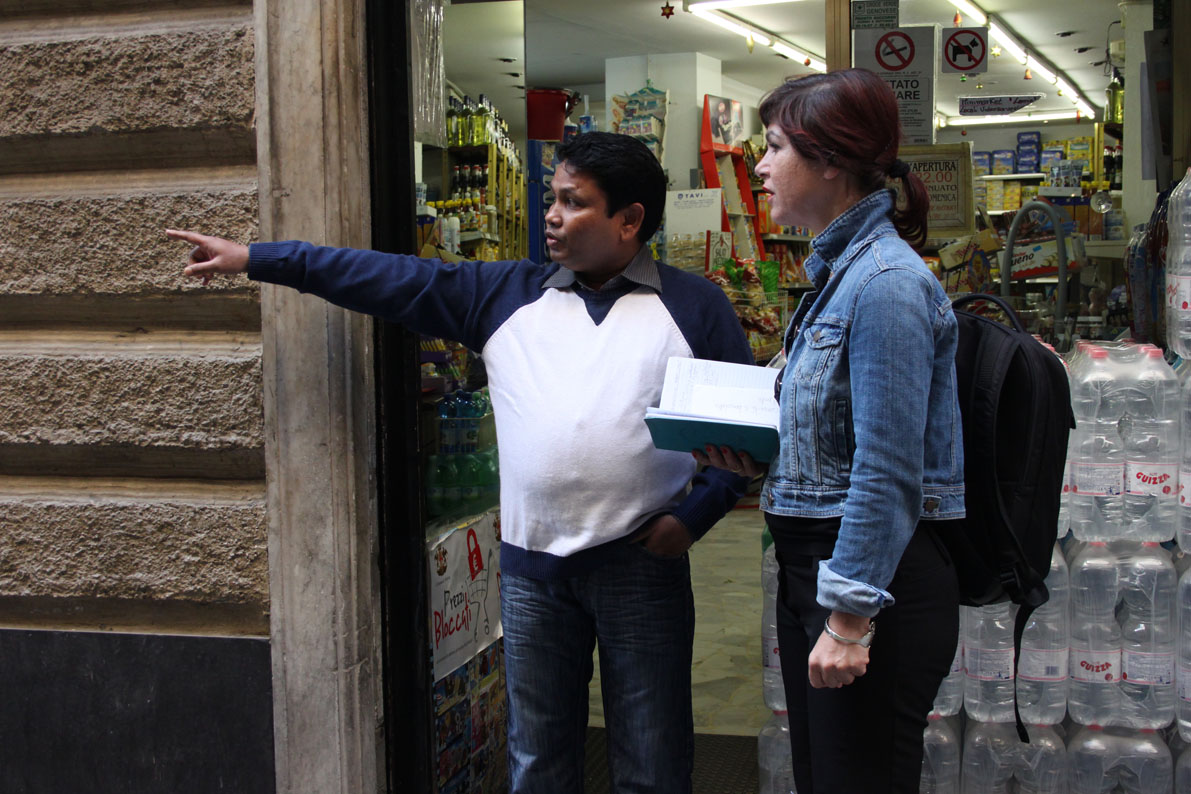
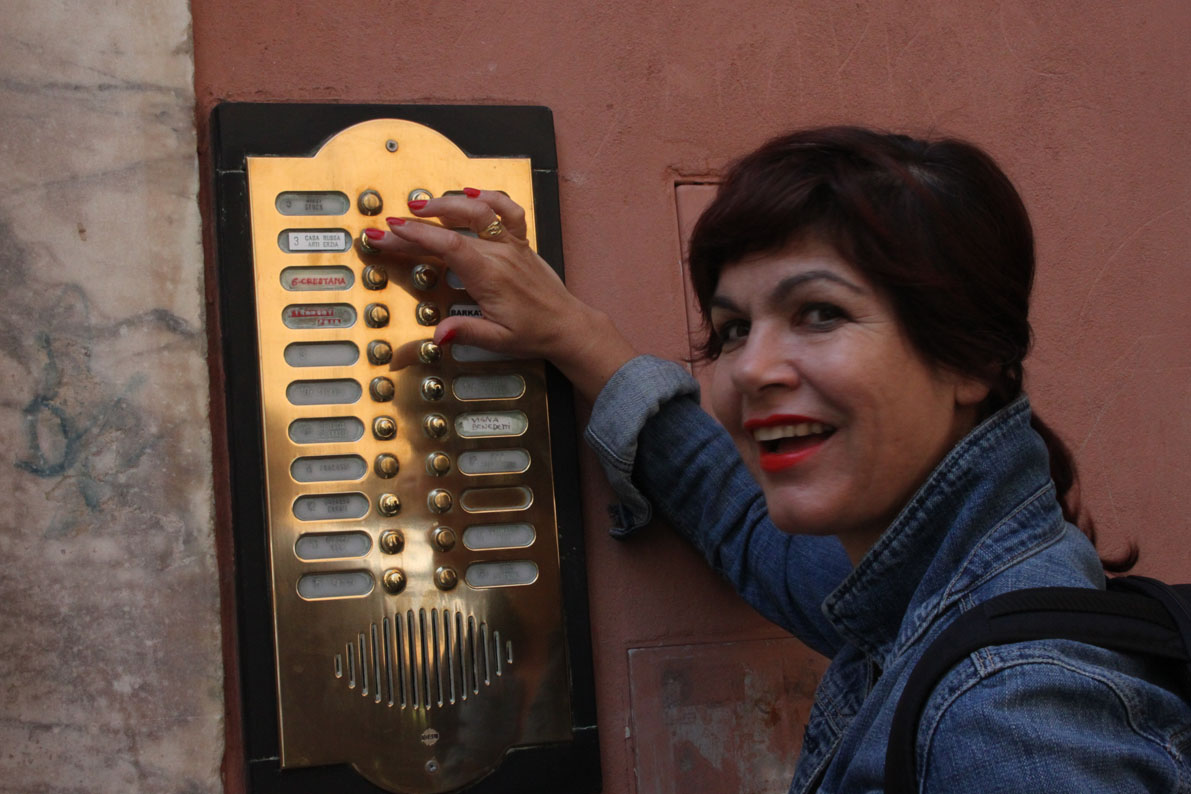
La Casa Russa (The Russian House)


Mr Lal introducing Liuba to a Community
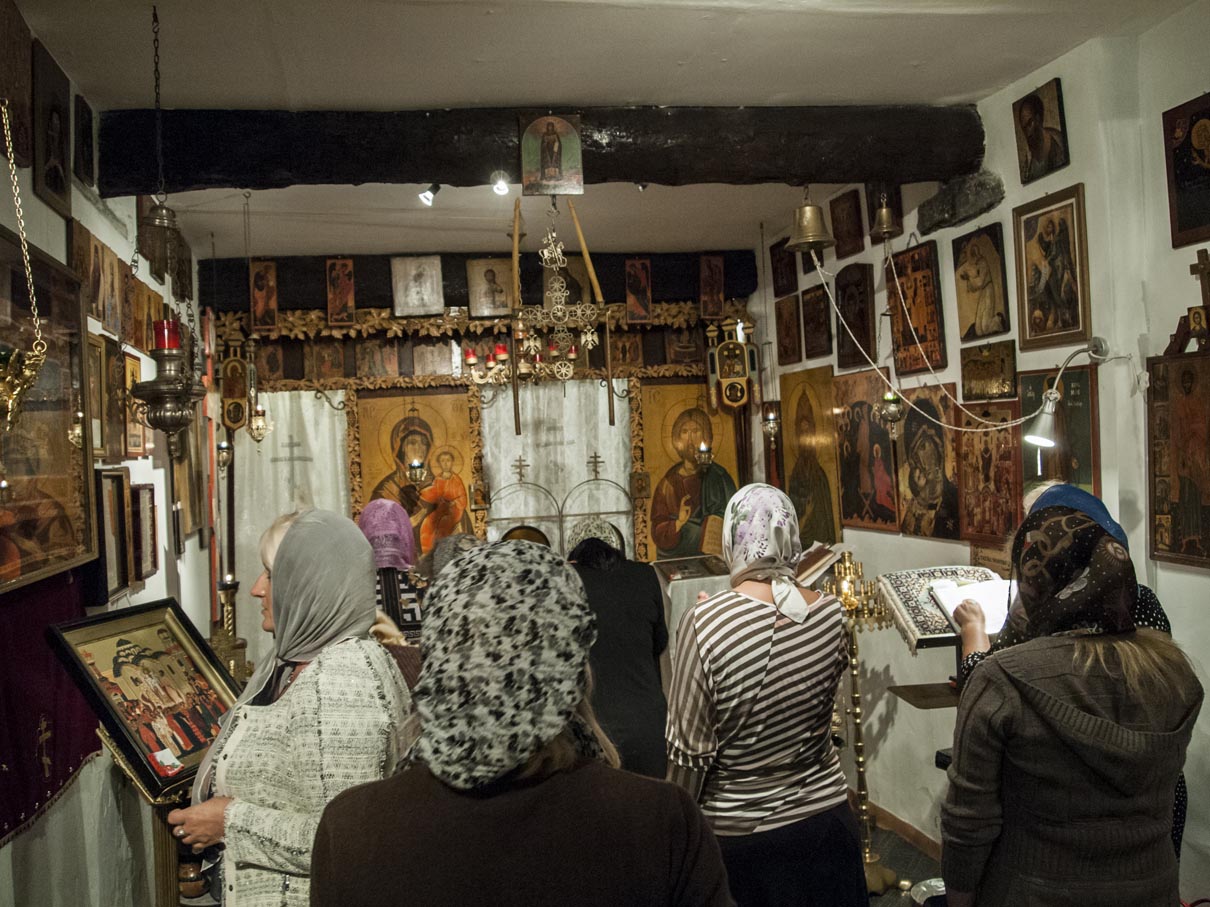
Russian Orthodox Church


The Jewish Sinagogue
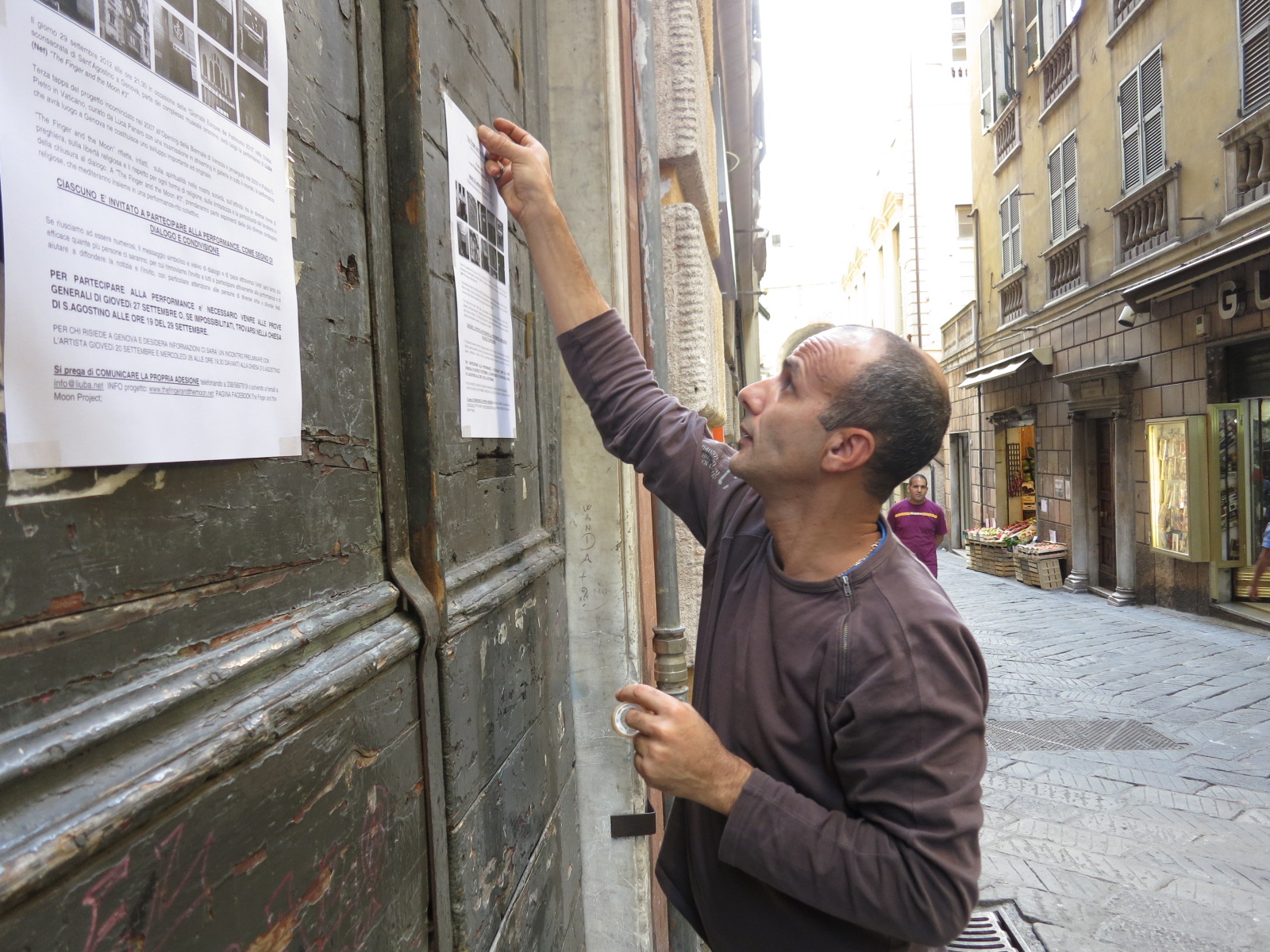
The Finger and the Moon flyers in via del Campo
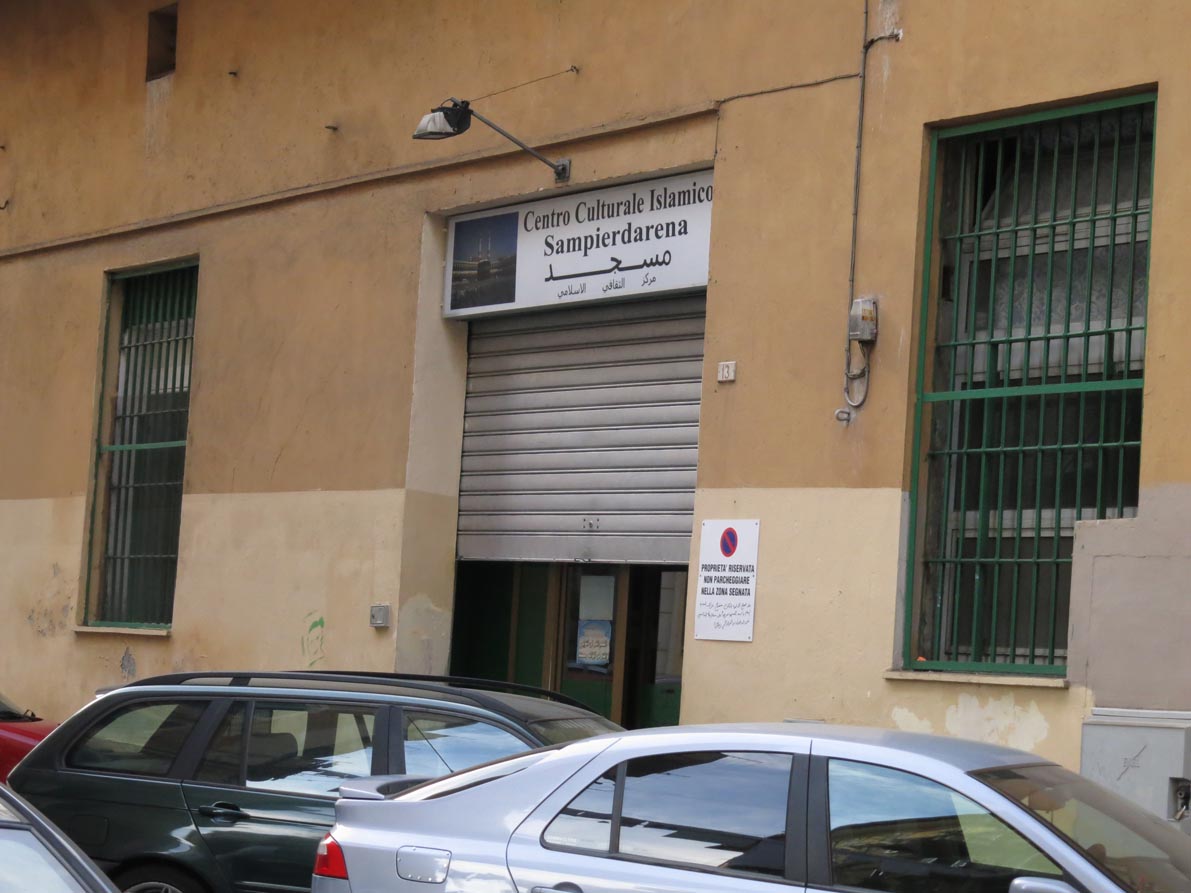
Sampierdarena Islamic Center

Porta Soprana, near where Liuba was staying by servas friend Carlo
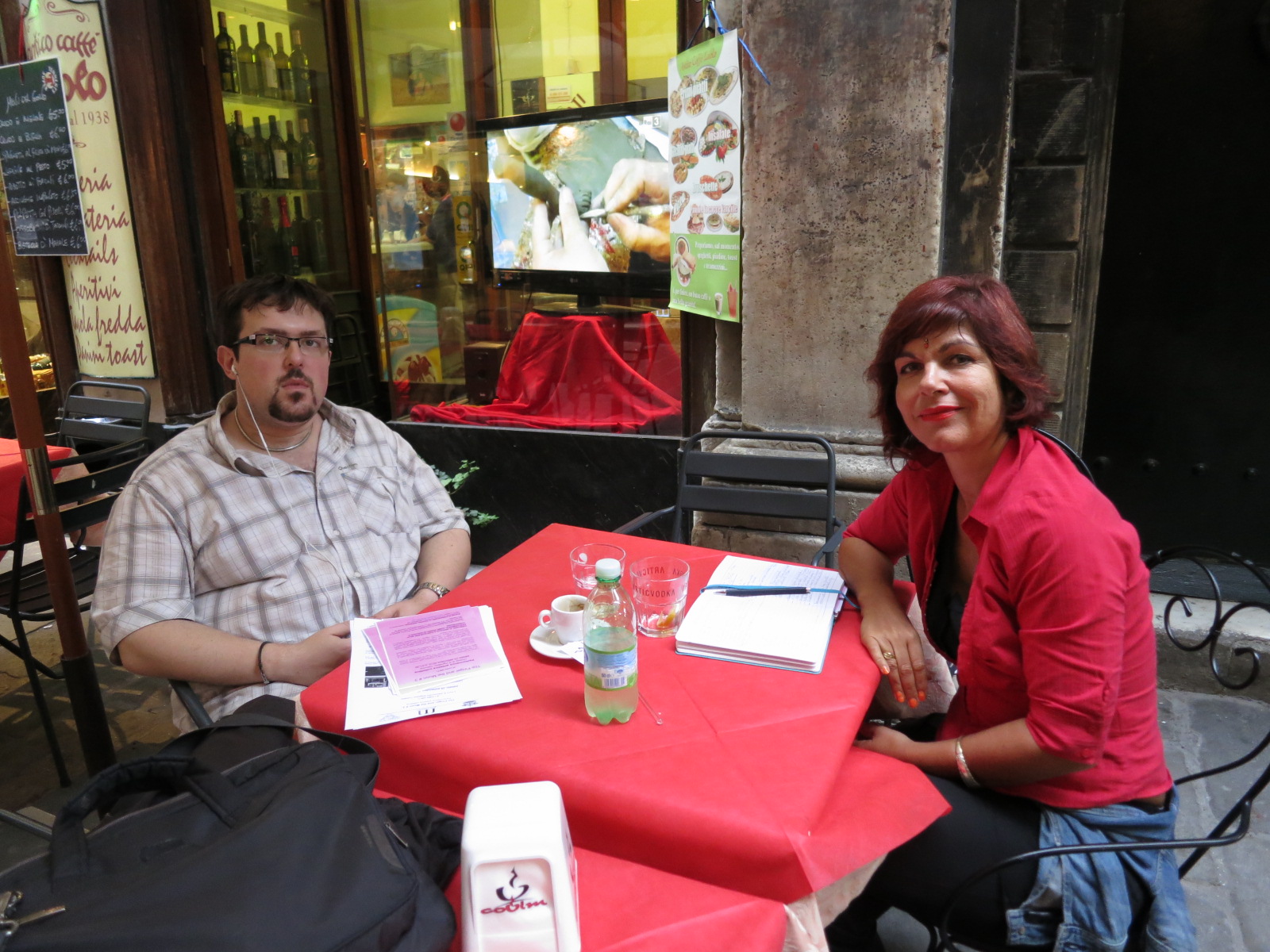
With Domenico of S. Egidio Community
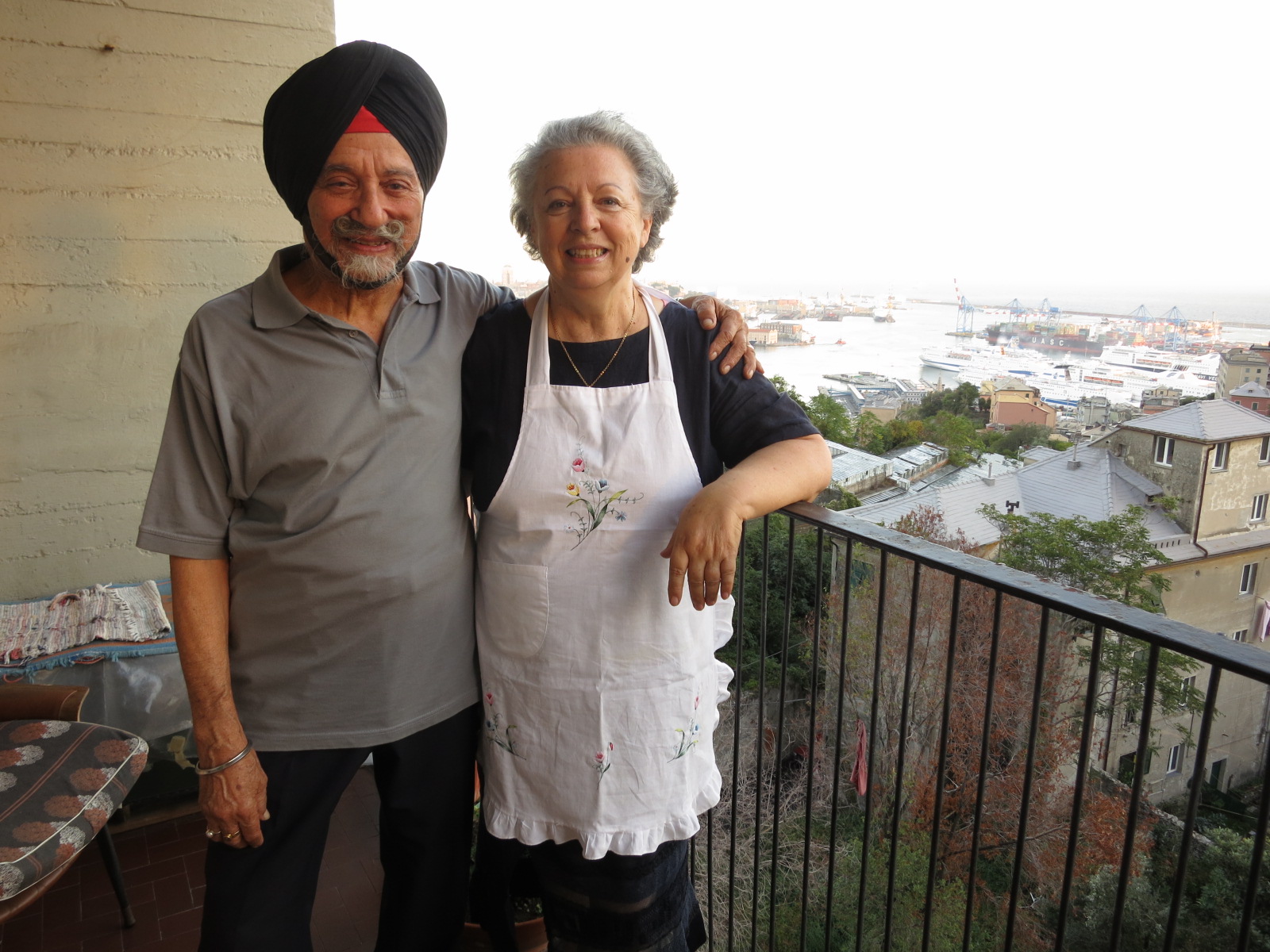
Dinner at mr Lal and his wife’s home
class="post-331 post type-post status-publish format-standard hentry category-english category-faith category-islam category-rituals" id="post-331
Posted on: November 29th, 2012 by Liuba
For the Finger and the Moon Project italian artist Liuba met the Imam of the Mosque in Milan who explained her how to perform the Islamic Prayer. She was invited to the viale Padova Mosque in Milan to pray with Islamic women. Liuba was very rispectful and with the intention to perform the prayer in the proper way.
Before Salaat
1. Body, clothes and place of prayer must be clean.
2. Perform wudu (ritual ablution) if needed.
3. Women are required to cover their hair.
4. Face the Qibla, the direction of Mecca.
5. Stand erect, head down, hands at sides, feet evenly spaced.
6. Recite Iqama (private call to prayer):
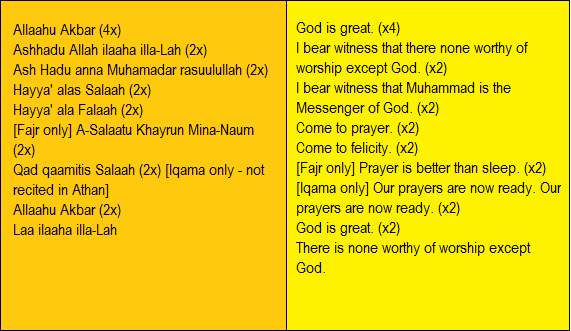 7. Express intent to perform Salaat (niyyat):
7. Express intent to perform Salaat (niyyat):
I intend to offer _____ rakats of the ____ prayer, and face the Qibla for the sake of Allah and Allah alone.
(For example: “I intend to offer the 4 rakats of the Isha prayer and face the Qibla for the sake of Allah and Allah alone.”)
Begin Salaat
1. Niyyat: Stand with respect and attention; put the world behind you.
Bring hands to ears, palms forward, thumbs behind earlobes and say (The entire prayer must be recited in Arabic, but for your information we give the English translation next to the Arabic transliteration) :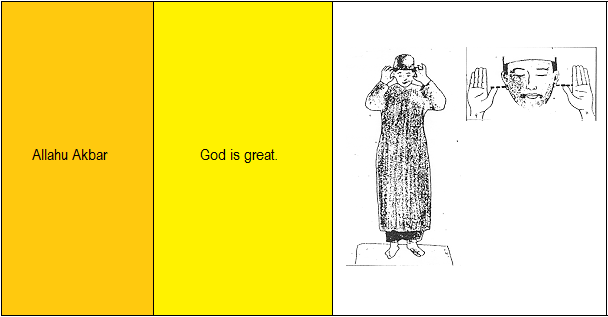
2. Qiyam: Place right hand over left, men below navel, women at chest level;
look at the ground in front of you and recite Opening Supplication (optional):

3. Fatiha: Recite aloud the Fatiha, the first surah of the Qur’an.

4. Ruk’u: Hands drop to sides; bend from waist, palms on knees, back parallel to ground; look at feet.

5. Qauma: Rise from bending to standing, arms at sides.

6.Sudjood;Prostrate-hands on knees, lower slowly to kneeling position; touch forehead, nose and palms to ground (but not elbows); bend toes so tops of feet face the Qibla.

7. Qu’ud: Rise to sitting position, looking at lap. Men turn up heel of right foot, right toes bent; women keep both feet, soles up, under body.
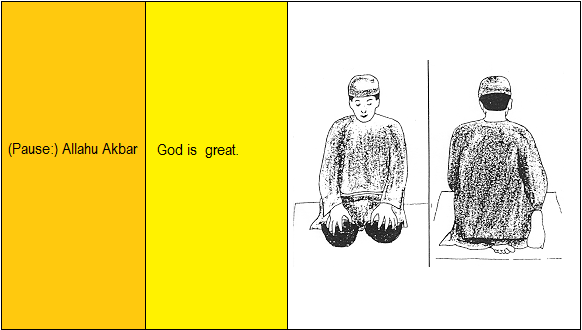
8. Sudjood: Prostrate again.
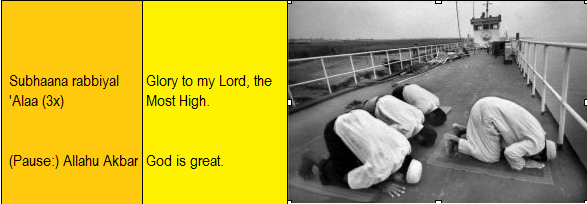
9. Qu’ud: Rise to sitting position;
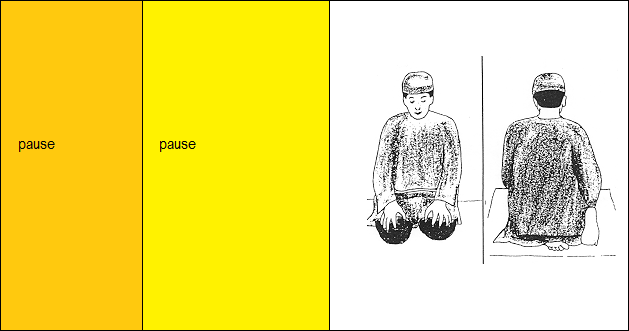
10.To proceed to the second and fourth rakats:
Then recite the Fatiha, (if this is the second rakat of any time of prayer, recite another short portion of the Qur’an); continue the second or fourth rakat with Ruku….
11. To complete every second rakat and the last rakat:
Remain seated and recite At-Tashahhud:1

To proceed to the third rakat:
Recite the Fatiha and continue third rakat with Ruk’u….
At the end of any time of prayer (when all rakats have been completed):
Remain seated, recite At-Tashahhud, and then recite the Salawat:
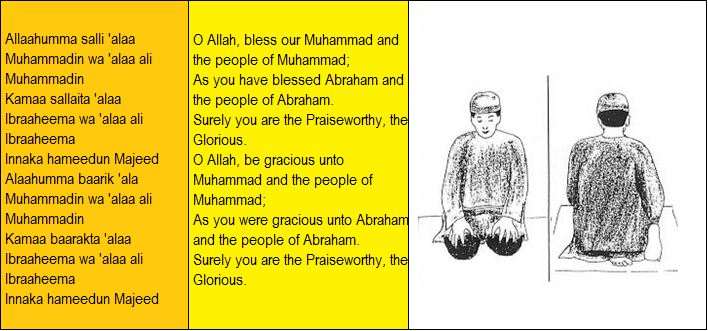
To Complete the Prayer: Look over right shoulder (toward the angel recording your good deeds), then the left (toward the angel recording your wrongful deeds); say each time:
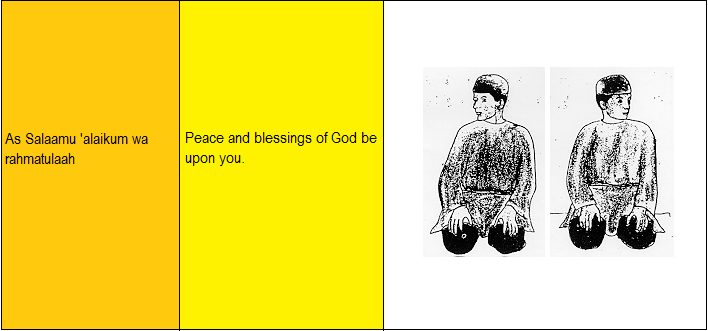
Say personal prayers with hands cupped and palms up at chest level.
Wipe face with palms.
If praying in a group, stand and greet each other individually,
saying: “May God receive our prayers.”
1At-Tashahhud is a recreation of the conversation held between Allah and the Prophet Muhammad (peace and blessing upon him) during the night of the Heavenly Ascent (Miraj)
class="post-307 post type-post status-publish format-standard hentry category-italiano category-faith category-taoism tag-cielo tag-numeri tag-simboli tag-taoismo tag-terra tag-ying-yang" id="post-307
Posted on: November 27th, 2012 by Liuba
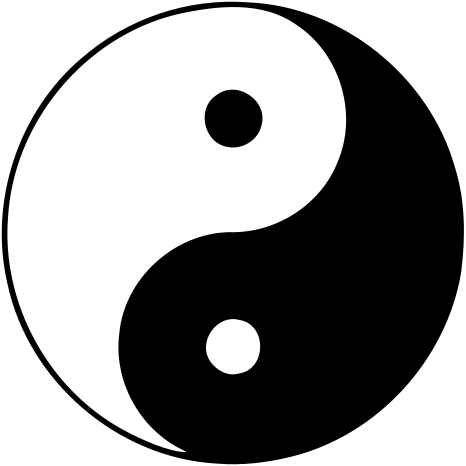
Nel Taoismo i Numeri sono concepiti all’interno di un sistema d’emblemi o simboli, nel quale non esprimono la quantità ma la qualità delle cose. Il Numero, in quanto Simbolo, permette di risvegliare un’intuizione che il solo linguaggio non può esprimere. Il Numero riesce ad attivare, nello stesso tempo, i molteplici “collegamenti” della mente umana, in altre parole, è capace di legare gli aspetti più diversi e permettere un’immagine d’insieme.
L’importanza dei Numeri è confermata dalla struttura di molti testi classici della filosofia cinese, come ad esempio lo Hongfan, il Daodejing e l’Yijing.
Quindi i Numeri agiscono come simboli, di cui la serie dall’Uno al Dieci è sufficiente a classificare l’universo e l’ordine della Creazione.
I segni da Uno a Cinque, sono detti Numeri di “apparizione”; cioè numeri preposti alla descrizione della creazione della vita, dalla produzione all’apparizione di un essere vivente. Dal Sei al Nove, incontriamo i Numeri che descrivono il suo sviluppo ed il suo “compimento”.
YI – UNO: Il TAO (DAO)
La difficoltà di spiegare ed interpretare il TAO (DAO) senza limitarne la vera natura nel descriverne il concetto, ha convinto i “Saggi” taoisti ad inserirlo all’interno di qualcosa d’altro, ad esempio un simbolo o meglio ancora, ad esprimerne il principio semplicemente con un numero, il Numero 1.
Dunque il Numero 1 non è soltanto un numero, ma, il Numero. E’ un simbolo numerico che aiuta a comprendere l’Unità Primordiale, l’Unità Fondamentale che è all’origine di tutti i fenomeni manifesti, il Tao, da cui hanno tratto origine tutti gli esseri:
“La Via generò l’Uno, l’Uno divenne il Due, il Due divenne il Tre, il Tre ha prodotto i Diecimila Esseri”
- Laozi dal “Daodejing – Il Libro della Via e della Virtù.
Da questo Numero si generano tutti gli altri e nello stesso tempo sono contenuti nella sua Grande Totalità, espressa dal Numero 10.
Scendendo di livello, l’Uno è collegato alla figura del CIELO (TIAN) e per analogia al PADRE.
ER – DUE: Il Dualismo YIN e YANG
L’Uno genera il Due.
Il TAO (DAO) è costituito da due aspetti, YIN e YANG, due entità opposte ma complementari che sono regolate da un mutuo rapporto di coesistenza, una non può esistere senza l’altra. Come per ombra e luce, basso e alto, dietro e avanti, unione e separazione, questi due principi non sono mai presenti separatamente. In ogni fenomeno è rappresenta la qualità più o meno elevata dell’uno e dell’altro; inoltre, essendo in continua “mutazione”, lo YIN e lo YANG si trasformano ciclicamente l’uno nell’altro.
Questa “qualità” è espressa dal Numero 2.
SAN – TRE: Cielo, Uomo, Terra
1 + 2 = 3 dunque l’UOMO (REN) come risultato della fusione tra CIELO (TIAN) e TERRA (DI). Al Numero 3 ben si addice, dunque, l’idea di CREAZIONE (origine, nascita, uscita, esteriorizzazione) verso un insieme completo (anima, corpo e spirito).
Tre sono le linee intere o spezzate che formano gli OTTO TRIGRAMMI (BA GUA).
Tre sono i livelli temporali: passato, presente, futuro.
Tre sono i Focolari (o Riscaldatori, Campi di Cinabro, SAN JAO) che mantengono la vita.
SI – QUATTRO: Tempo e Spazio
La ciclicità delle stagioni, in una cultura prevalentemente contadina, ne scandisce il TEMPO.
Xia, Estate XIA – ESTATE TAI YANG, Grande Yang
Qiu, Autunno QIU – AUTUNNO SHAO YIN, Piccolo YIN
Dong, Inverno DONG – INVERNO TAI YIN, Grande Yin
Chun, Primavera CHUN – PRIMAVERA SHAO YANG, Piccolo Yang
Simbolicamente il Numero 4 richiama il QUADRATO (anche il suo ideogramma significa cintato, chiuso), la delimitazione di uno SPAZIO e la sua identificazione nelle quattro direzioni, nei quattro punti cardinali: SUD (NAN), NORD (BAI) , EST (DONG) e OVEST (XI).
WU – CINQUE: Il Centro
Il ciclo di mutazione dal Massimo Yang (Numero 3) raggiunge il Massimo Yin (Numero 2) e torna nuovamente al Massimo Yang, in un movimento senza fine.
Questa rotazione avviene attorno un CENTRO (Il Perno, il Capo, l’IMPERATORE) identificato dal Numero 5.
La nozione di CENTRO, spesso, viene assimilata a quella di vuoto mediano, in seno al quale si svolge la vita.
Il 5 è posto al centro della serie di numeri che vanno dal Numero 1 (l’Unità) al Numero 9 (il limite accessibile alla conoscenza umana) che classificano l’Universo: 1 2 3 4 5 6 7 8 9.
Ora, la TERRA (DI), su cui avviene il mutarsi di tutte le cose, muta a sua volta, diventando operativa e la sua valenza passa da 2 a 5. La creazione si è compiuta con il Numero 5 che conclude la serie dei numeri che descrivono la creazione della vita.
Il Numero 5 è il valore del MOVIMENTO TERRA (TU) all’interno del Ciclo dei Cinque Movimenti (WU XING).
Secondo la numerazione data, in base al “valore o rango”, ai vari movimenti (elementi) data dallo HONG FAN, l’Acqua assume valore 1, il Fuoco 2, Legno 3, il Metallo 4 e la Terra 5.
Shui, Acqua 1. SHUI – ACQUA
Huo, Fuoco 2. HUO – FUOCO
Mu, Legno 3. MU – LEGNO
Jin, Metallo 4. JIN – METALLO
Tu, Terrea 5. TU – TERRA
see more:
http://nuke.tuiillago.it/MTCeFilosofia/NumerieSimboli/tabid/577/Default.aspx
http://lalunanellago.blogspot.it/2010/02/lalchimia-dei-numeri.html
class="post-280 post type-post status-publish format-standard hentry category-english category-art-and-culture category-dialog category-multireligious tag-america tag-cornerstone-theatre tag-faiths tag-los-angeles" id="post-280
Posted on: November 25th, 2012 by Liuba

Cornerstone Theater Company is a multiethnic ensemble-based theater company. Since its founding in 1986, Cornerstone has pursued a mission of inclusion by creating a theater that builds bridges between and within diverse communities. In their words, “We believe society can flourish only when its members know and respect one another, and that we have a responsibility to make theater in this spirit.” Cornerstone productions have consistently engaged civic dialogue. Their biracial Romeo and Juliet in Mississippi helped spark and support dialogue about de facto racial segregation of the public and private schools. Since they moved to Los Angeles in 1992, Cornerstone has worked to build bridges in their home city. The Faith-Based Theater Cycle provided an opportunity for Cornerstone to engage multiple communities around a powerful and often challenging theme—and to work in depth, over time, and with cumulative impact.
Having witnessed the bombing of a local Jewish community center, and having seen how quickly Islamic fundamentalists were blamed for the Oklahoma City bombing, Cornerstone felt the acute need for a faith-based project on a civic as well as a personal level. “In fact,” they reflected with foresight in 2000, “faith-based civic issues get at the messy heart of the founding of the nation.” The Faith-Based Theater Cycle was just unfolding when the September 11 terror attacks took place, and the event provided a new context and urgency for an exploration of “how faith unites and divides American society.”
The Faith-Based Theater Cycle is ambitious in scope and diversity. The four-and-a-half–year project began with a Festival of Faith, a trial by fire involving 21 productions at five religious venues, and an audience-participatory ensemble production, Zones, that was later remounted to incorporate audience feedback. Three multiweek series of dialogues called Weekly Wednesdays, with the themes of ritual, believing, and social justice, preceded and followed the festival. Six community collaborations and productions included immigrant Catholics, Jews, Muslims, Hindus; African American clergy with African American people infected with or affected by HIV/AIDS; and multifaith gay, lesbian, bisexual, and transgender participants.
read more: cornerstone_case_study
http://cornerstonetheater.org/about/history/
class="post-149 post type-post status-publish format-standard hentry category-english category-italiano category-bahai-faith category-buddhism category-christianity category-dialog category-faith category-hinduism category-islam category-judaism-faith category-multireligious category-native-americans category-blognetwork category-picturesvideo category-taoism category-project tag-29-settembre tag-alessandra-gagliano-candela tag-art tag-arte tag-chiesa-di-s-agostino tag-christians tag-elisabetta-bianchetti tag-faiths tag-genova tag-hindu tag-inter-religious-dialogue tag-islamic-calendar tag-jewish tag-liuba tag-liuba-net tag-meditation tag-museo-di-s-agostino tag-performance tag-performance-collettiva tag-religione tag-religions tag-spiritualita tag-the-finger-and-the-moon tag-tolerance" id="post-149
Posted on: November 15th, 2012 by Liuba
Genoa, sept 29, 2012, Deconsacrated Gothic Church of S.Agustin Museum
After a year of site specific research and networking in the city of Genoa by the Italian artist Liuba supported by anthropologist Barbara Caputo, 12 people of different spiritual faith and beliefs participated with Liuba in the collective performance, curated by Alessandra Gagliano Candela.
Dopo una lavoro di ricerca antropologica e di contatti sul campo durato circa un anno e portato avanti dall’artista insieme all’aiuto dell’antropologa Barbara Caputo e della curatrice Alessandra Gagliano Candela, hanno partecipato alla performance collettiva insieme col’artista Liuba 12 persone di diverse fedi religiose e cammini spirituali.

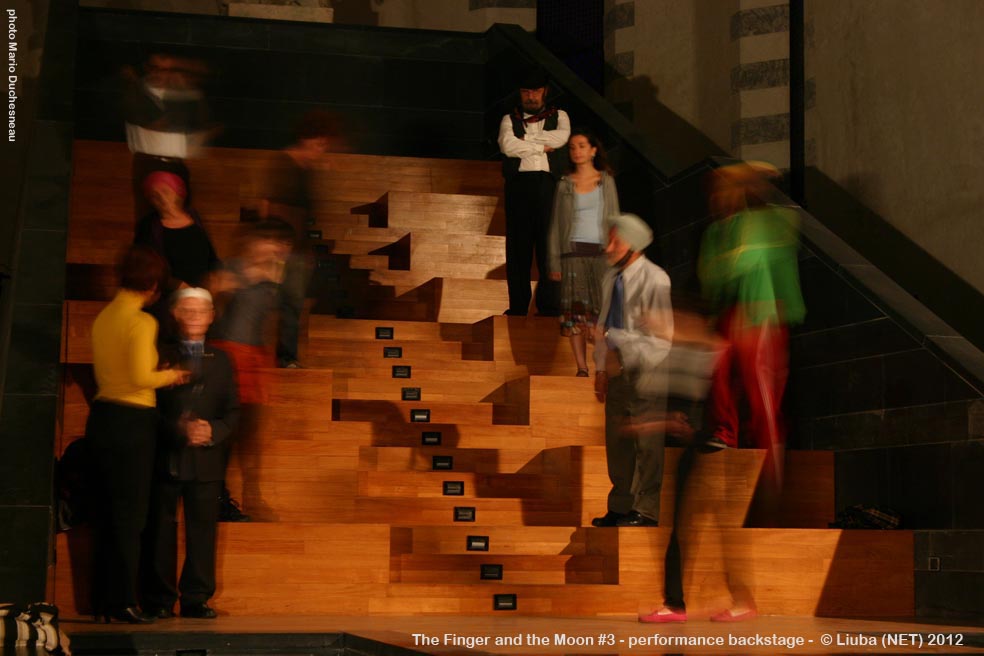
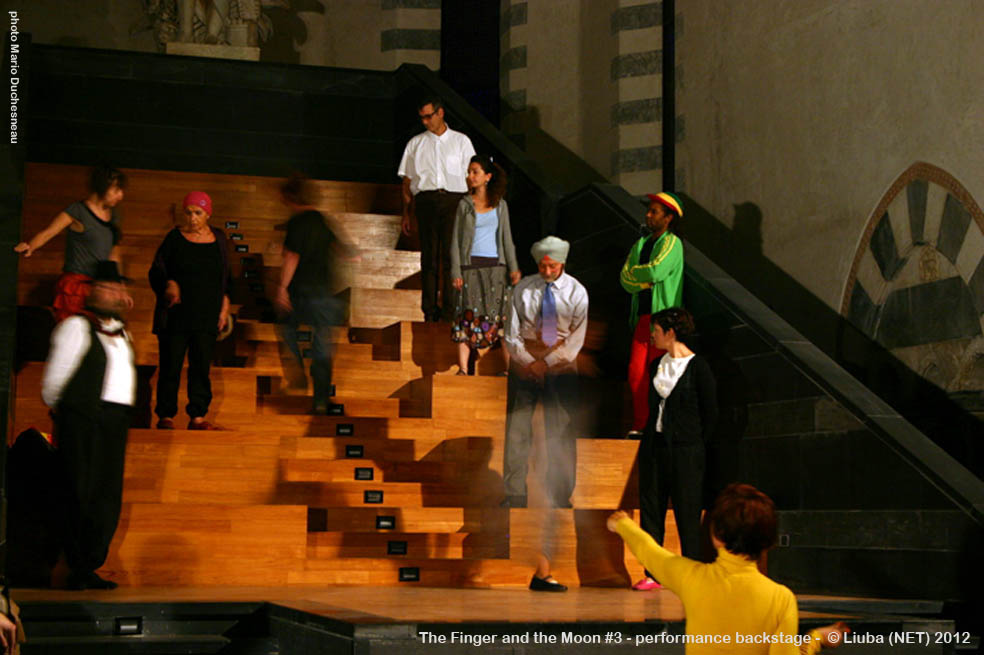

Participants met with Liuba into the Deconsacrated Church a few hours before the performance began.The artist explained the importance of everyone feeling well, relaxed and free during the performance; being part of a performance is not like acting in the theater rather it is being natural and true. All the people involved were free to meditate and act in any way he or she liked, needing only to keep in mind simple logistical/spatial rules previously decided upon.
I partecipanti si sono incontrati con Liuba nella chiesa sconsacrata alcune ore prima della performance. Liuba ha sottolineato che era importante che ciascuno fosse sè stesso e agisse con naturalezza e spontaneità, poichè si trattava di una performance e non di uno spettacolo teatrale. Ciascuno era libero di meditare e pregare nella maniera a lui più appropriata, condividendola con gli altri, e rispettando soltanto alcune semplici indicazioni di regia spaziale.
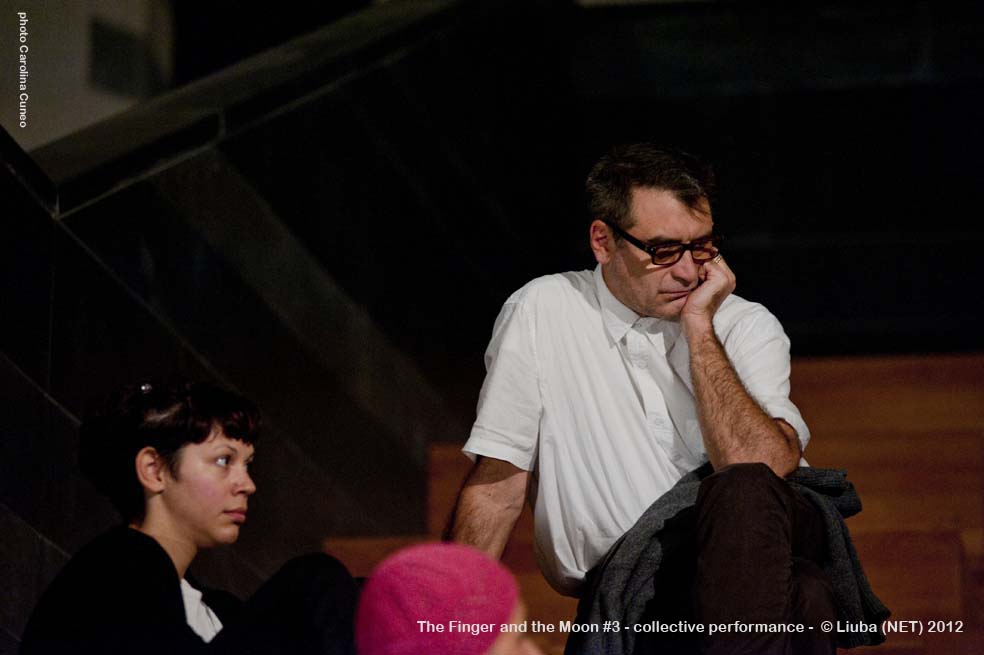



Participants introduced themselves to the others, explaining their reasons for taking part in this important piece of performance art and symbolic faith sharing event.
Ciascuno ha condiviso le motivazioni per cui aveva scelto di essere parte della performance e di meditare insieme a persone di diverse appartenenze religiose. Ogni partecipante era ben consapevole di essere parte di un’opera d’arte e al tempo stesso di un evento simbolicamente importante sulla strada dell’accettazione e del rispetto delle varie spiritualità.
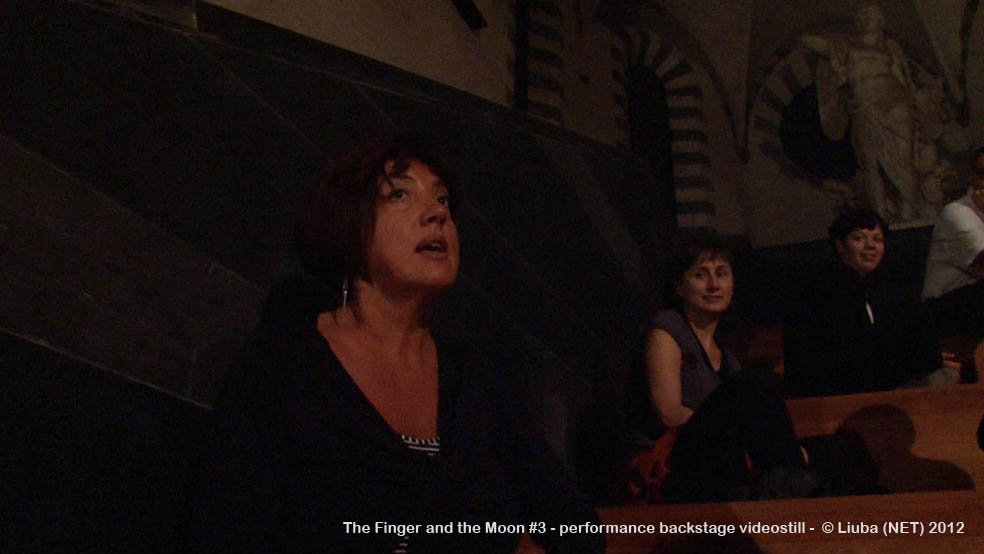
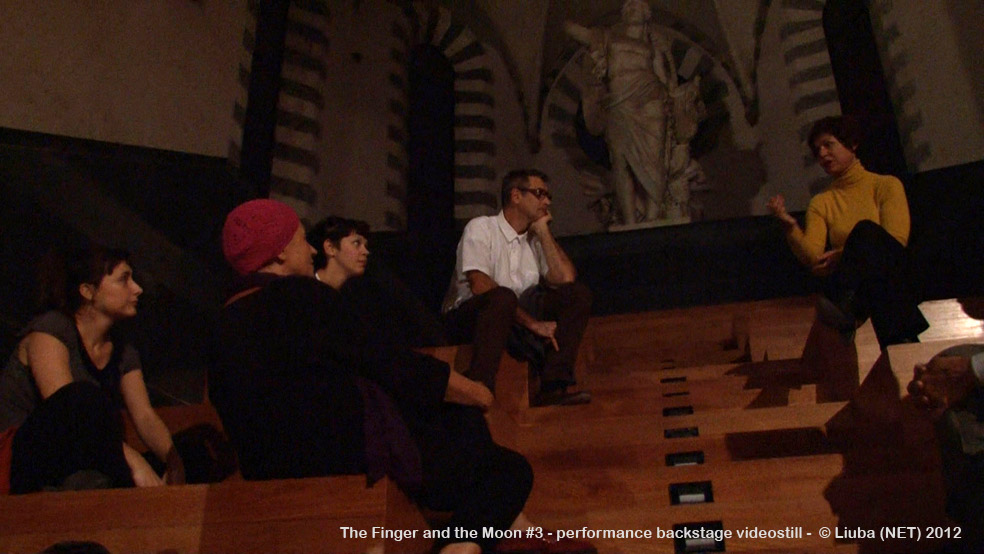

The collective performance began with all the participants on the steps of the church’s apse breathing in unison; respiration is a universal need that is common to all people, religious or otherwise.
La performance collettiva è cominciata con tutti i partecipanti sulla grande scalinata che respiravano insieme. Il respiro è un bisogno e una pratica che unisce tutti gli uomini di ogni diversa provenienza e spiritualità.
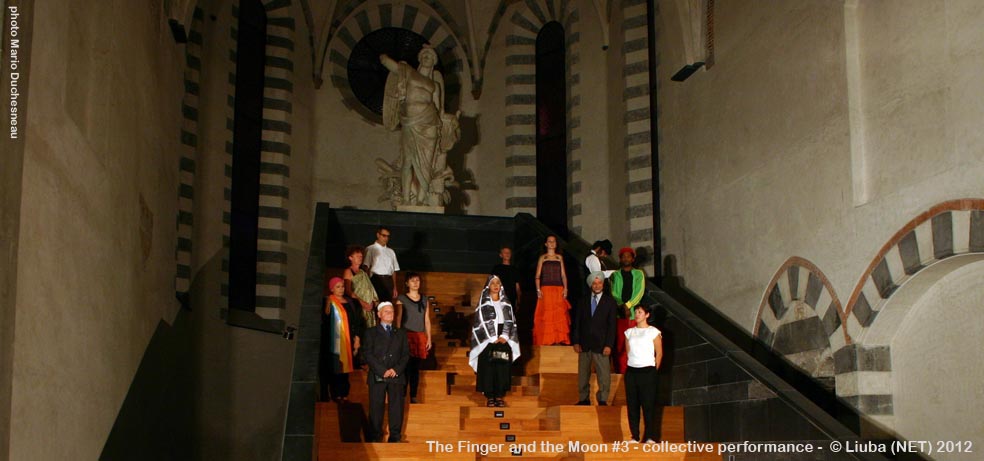




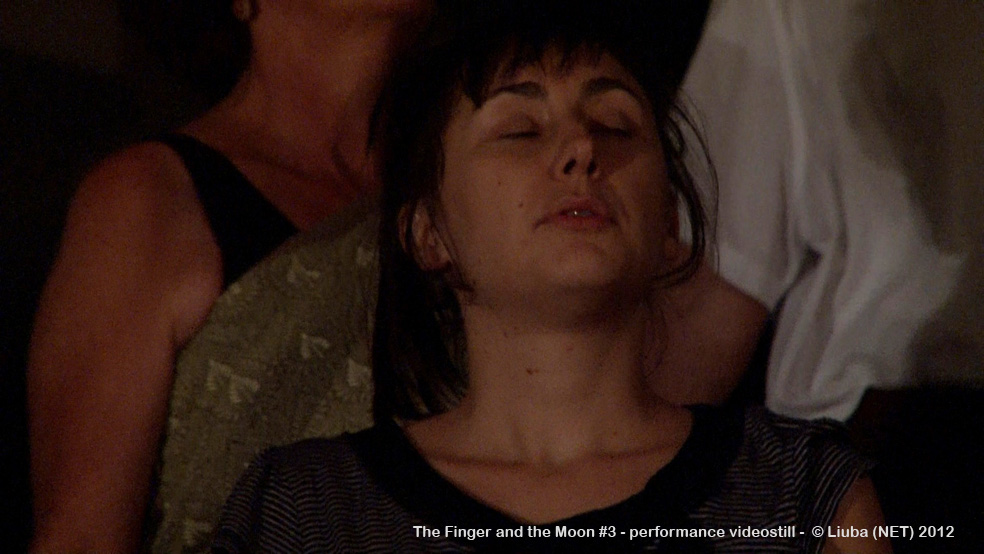


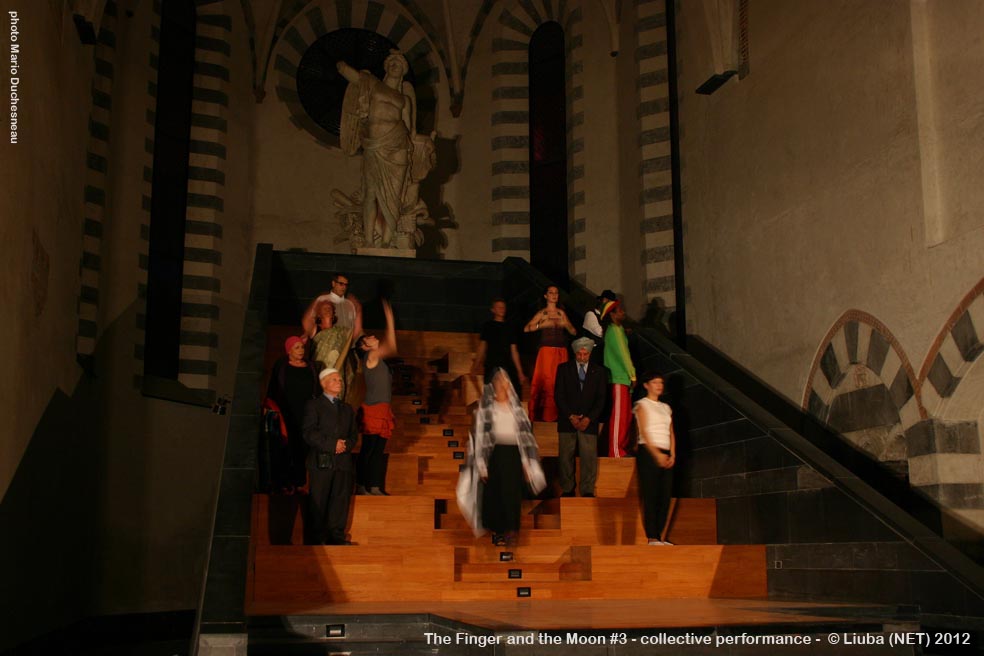
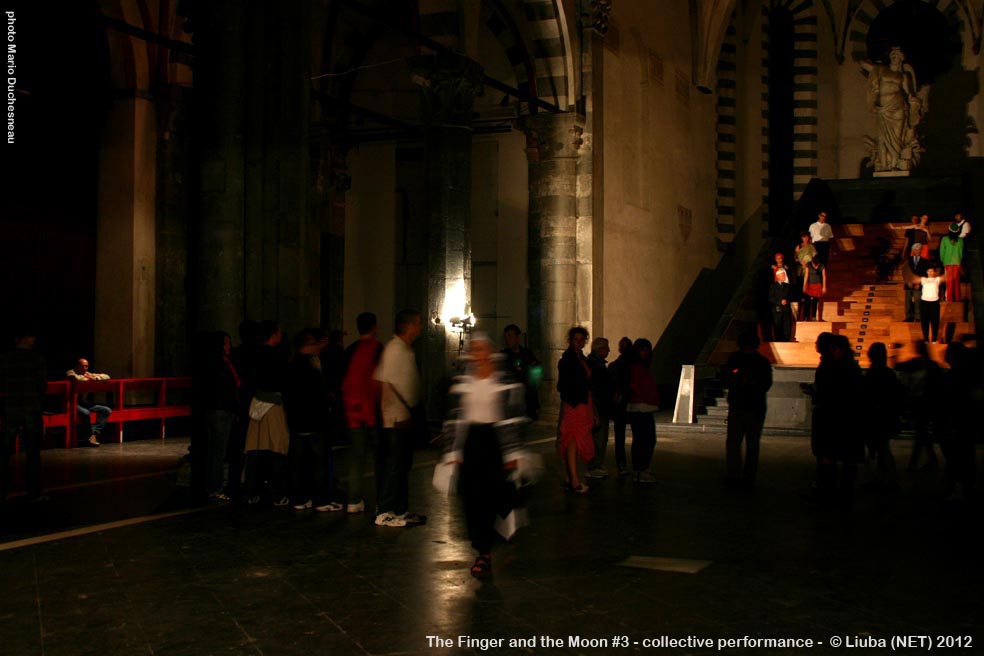
Then Liuba descended into the nave, moving among the public and praying various prayers of many religions. On her ad hoc oufit were images of several places of worship, temples and churches in New York City. The participants then descended, one by one, into the nave while meditating individually in their own, personal ways. There was music composed for the event by Liuba which mixes together some sacred music of various religions and video projections of the Finger and the Moon project videos #1 and #2.
Quindi Liuba discese nella navata, in mezzo al pubblico, e cominciò a meditare con preghiere di diverse fedi. Sul suo manto-opera erano raffigurati tempi e chiese di differenti religioni. E ad uno a uno, anche gli altri partecipanti discesero nella navata cominciando le loro meditazioni, muovendosi nello spazio con libertà e improvvisazione. C’era una musica composta da Liuba sovrapponendo musica sacra di diverse religioni, e l’installazione dei due video ‘The Finger and the Moon #1 e 2′ all’inizio della navata.
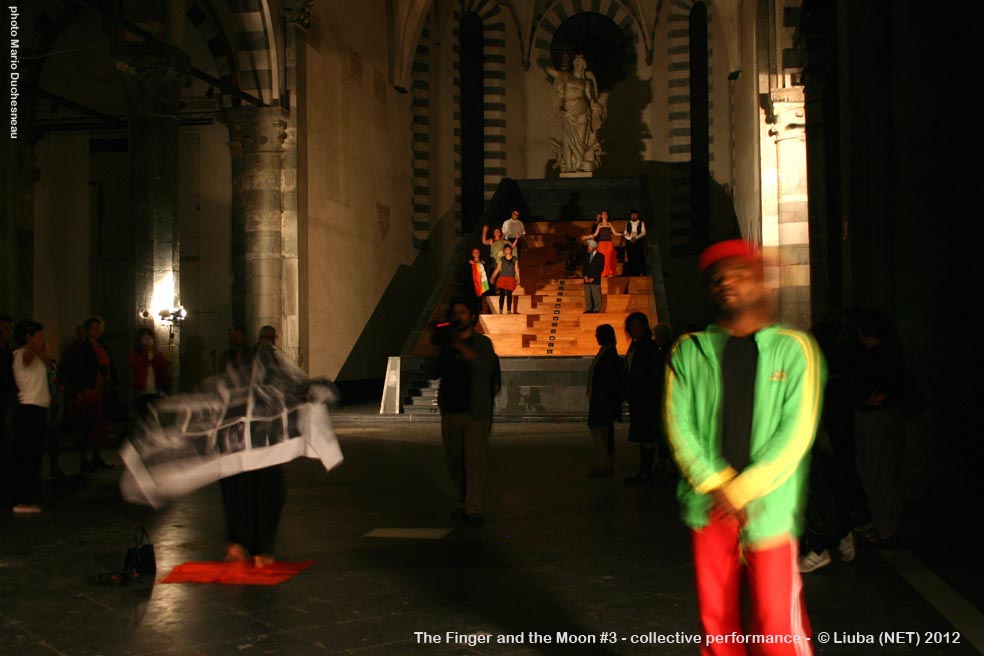


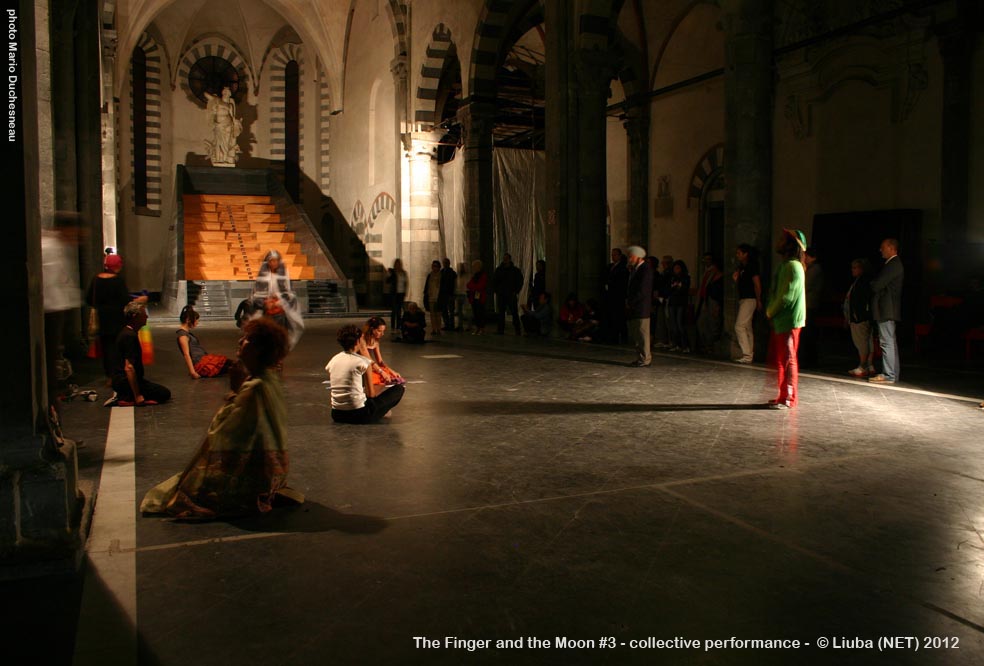
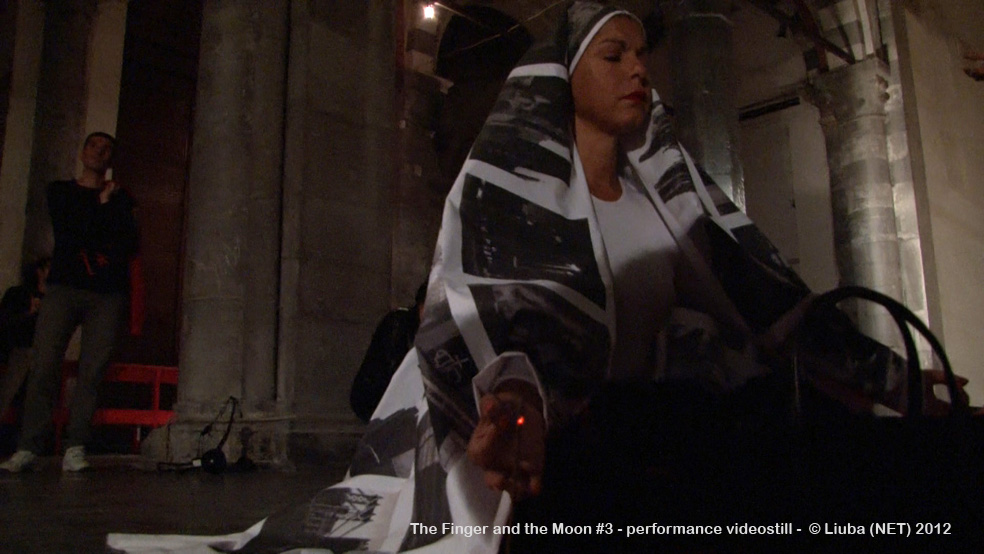


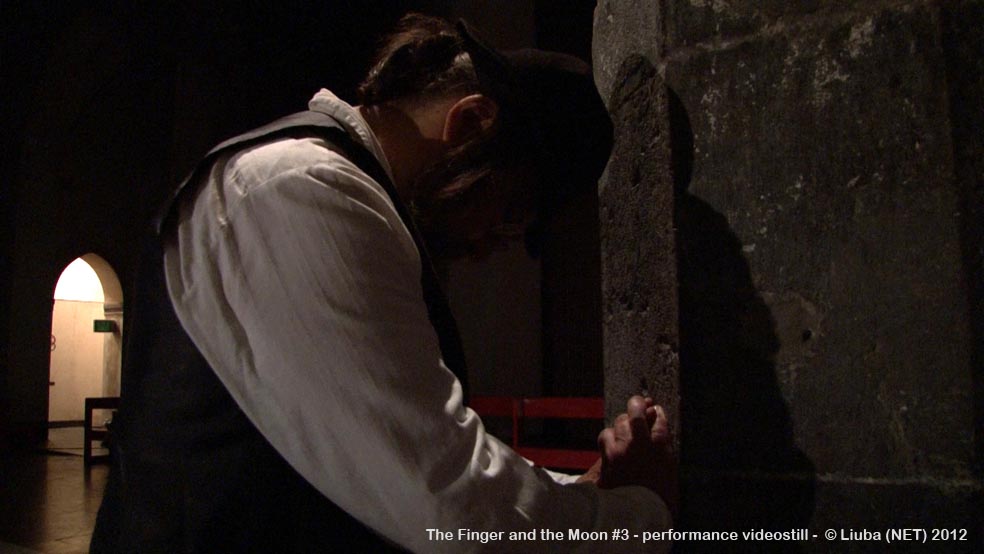



The performance ended with Liuba writing ‘The Finger and The Moon’ sentence on the floor of the church and then leaving the church and entering the real world and everyday life hand-in-hand with all the participants.”
La performance si concluse con Liuba che, dopo aver scritto sul pavimento della navata la frase di Finger and the Moon, raccolse tutti i partecipanti conducendoli per mano fuori dalla chiesa, nel mondo reale, verso la vita di ogni giorno.

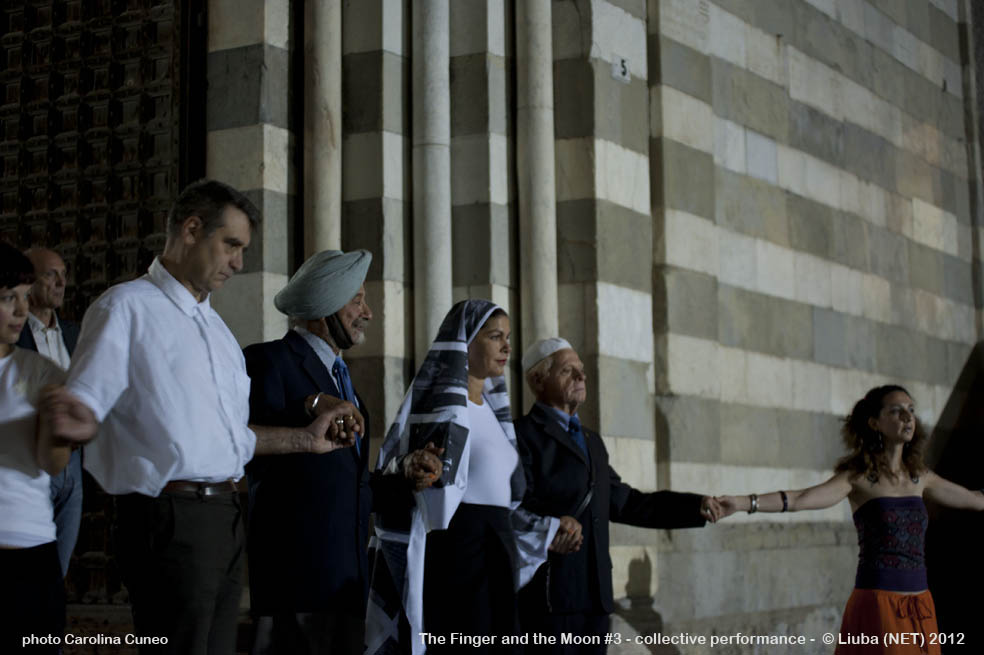

see more picture in the website gallery
see more pictures on the project facebook page
read the performance pressrelease
class="post-145 post type-post status-publish format-standard hentry category-english category-faith category-rituals tag-islamic-calendar tag-islamism tag-muharram tag-muslim-new-year" id="post-145
Posted on: November 15th, 2012 by Liuba
Today, November 15, 2012, is the first day of the Month of Muharram and Muslim celebrate the New Year, 1434 according to the Islamic calendar.
The Islamic year lasts for about 354 days and consists of 12 months. Muharram is the first month and some Muslims mark the start of the Islamic year on the first day of Muharram. Many Muslims fast during daylight hours on the ninth and 10th or 10th and 11th days of the month to mark the Day of Ashura (Yaumu-l ‘Ashurah).
Muslims do not traditionally “celebrate” the beginning of a new year, but they acknowledge the passing of time, and take time to reflect on our own mortality.
Muslims measure the passage of time using the Islamic (Hijrah) calendar. This calendar has twelve lunar months, the beginnings and endings of which are determined by the sighting of the crescent moon. Years are counted since the Hijrah, which is when the Prophet Muhammad migrated from Makkah to Madinah (approximately July 622 A.D.).
The Islamic calendar was first introduced by the close companion of the Prophet, Umar ibn Al-Khattab. The Islamic calendar is the official calendar in many Muslim countries, especially Saudi Arabia. Other Muslim countries use the Gregorian calendar for civil purposes and only turn to the Islamic calendar for religious purposes.
Happy New Year and Salaam aleikum!
class="post-119 post type-post status-publish format-standard hentry category-english category-dialog category-faith category-multireligious tag-architecture tag-berlin tag-faiths tag-inter-religious-dialogue tag-petriplatz tag-three-religions" id="post-119
Posted on: November 8th, 2012 by Liuba
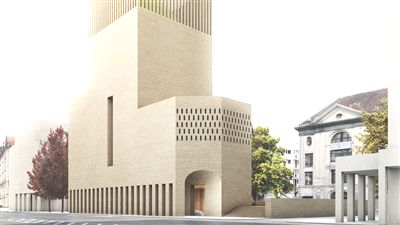
A house of prayer and learning for Jews, Muslims and Christians is planned for Petriplatz in Berlin.
To launch the project, the Jewish Community of Berlin, the Abraham Geiger College Potsdam, the Forum for Intercultural Dialogue and the Evangelical Church Association St. Petri-St. Marien founded an official association called The House of Prayer and Learning at Petriplatz Berlin.
Inter-religious dialogue
The new building should rise from the foundations of the former Church of St. Petri in Berlin Mitte. Three different spaces are planned in which prayer services for Jews, Christians and Muslims can be held. The three spaces will be joined by a hall where festivals and possibly even religious ceremonies can be celebrated together.
The jury awarded the first prize to the Berlin architect office Kuehn Malvezzi. Their winning design takes inspiration from the structure of the former Church of St. Petri. With its light brick façades and a 44-meter (144-foot) high tower, the proposed prayer house looks a bit like a fortress.
But slick geometric forms are to dominate the interior, and a two-storey domed hall will serve as a shared learning space.
“The fourth space constitutes a public space stretching between the three religions. It is a space for understanding and debate. Dialogue has something to do with a certain type of limitation. The project also aims to show where the differences lie,” one of the architects, Wilfried Kuehn, told DW.
http://www.dw.de/berlin-plans-prayer-house-for-three-religions/a-16314461
An exhibition currently shows the plans for the proposed House of Prayer and Learning
The former Church of St. Petri
Archeological treasures
Gregor Hohberg, minister at the Evangelical Church Association St. Petri-St. Marien and chairman of the Petriplatz association, is pleased with the design. But he emphasizes that an “amalgamation” of religions is not really intended, rather “we want much more to learn how to approach one another with dignity and respect.”
Today, Petriplatz is little more than a fenced-in piece of scrubland. Until five years ago, the site was a miserable-looking car park. One lonely street sign read, “Petriplatz.” But that changed when the land was cleared in 2007.














































































